
What is a typical day like for you?
I begin my day early, though these days, “early” often means as late as 6 a.m. Even as a child growing up in my village in Madampe, I would rise around five, just as the sky came alive with stunning colours. Now that we live in cities, I often feel that we’re trying to reconnect with the experiences of our childhood.
Each morning, as I drink my tea, I tend to lose myself in thought. I find quiet joy in the tactile and visual experiences the outside world offers, whether it’s the texture of a leaf or the sound of birdsong. Nature often reveals its hidden wonders when you begin to pay closer attention. Things you may never have noticed before suddenly come into view.
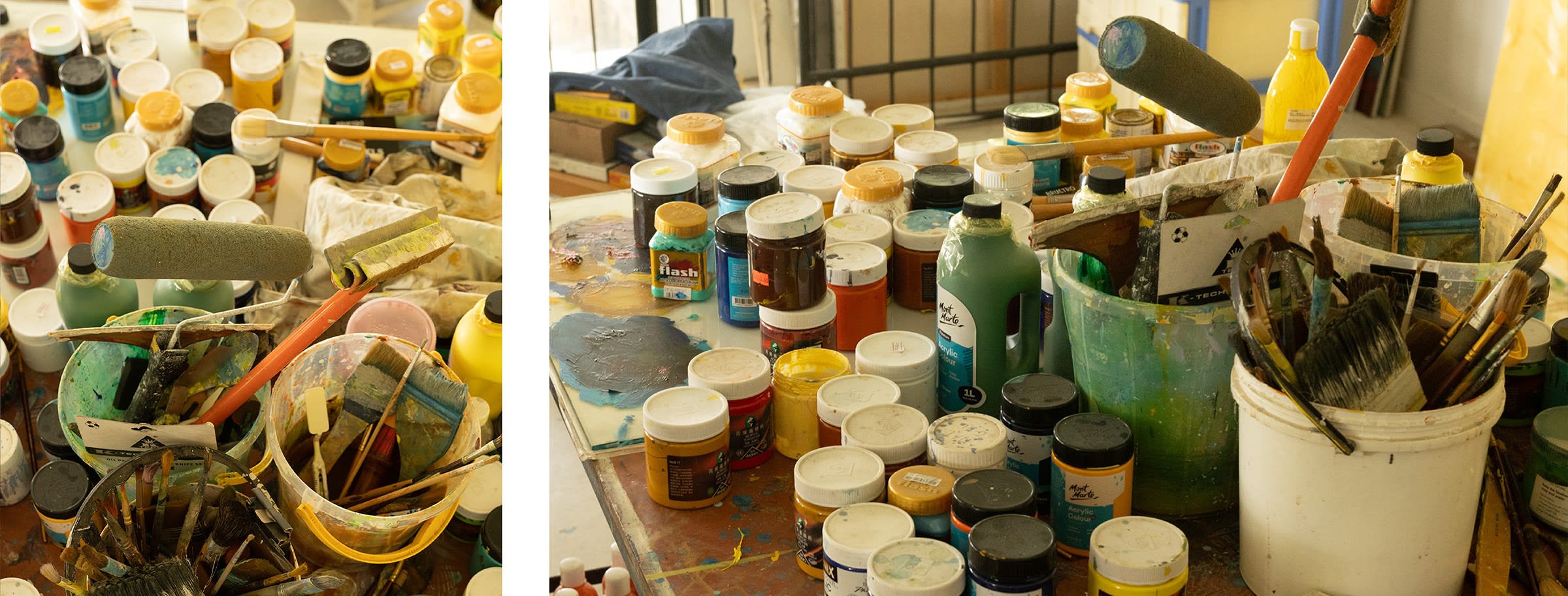
Jagath Ravindra's studio in Colombo, Sri Lanka
What initially drew you to abstraction, and what continues to hold your interest in it?
I am considered an abstract artist. However, I think it is a classification that does not reflect the movement itself. What I would say is that the reason why I choose to use the grammar of abstract art as my visual language is more a matter of taste. What we as artists in the contemporary moment practice are more a subset of visual grammar that resulted from the movement and has become the defining principles of the style that we call abstract art today.
I am interested in capturing the emotions that arise through my engagement with the environment around me and the ideas I attempt to unpack. I enjoy working with the grammar of abstraction. The way we think, as I understand it, is shaped by our neurochemistry, education, experiences, and everything we learn, read, and absorb. All of this informs our visual language as artists. As individuals, we tend to hold on to what resonates most deeply with us. I am deeply drawn to the harmony that emerges between deliberate, premeditated actions which emerge from both conscious and unconscious processes — and those that arise spontaneously, without planning. This is perhaps why I prefer working with the grammar of abstract art.

Jagath Ravindra
My process is quite simple. Mine is a desire to work with colours and create expansive works. Once I put an idea to paper, the idea is lost to me. Hence I don’t sketch beforehand.
What initially drew you to abstraction, and what continues to hold your interest in it?
I am considered an abstract artist. However, I think it is a classification that does not reflect the movement itself. What I would say is that the reason why I choose to use the grammar of abstract art as my visual language is more a matter of taste. What we as artists in the contemporary moment practice are more a subset of visual grammar that resulted from the movement and has become the defining principles of the style that we call abstract art today.
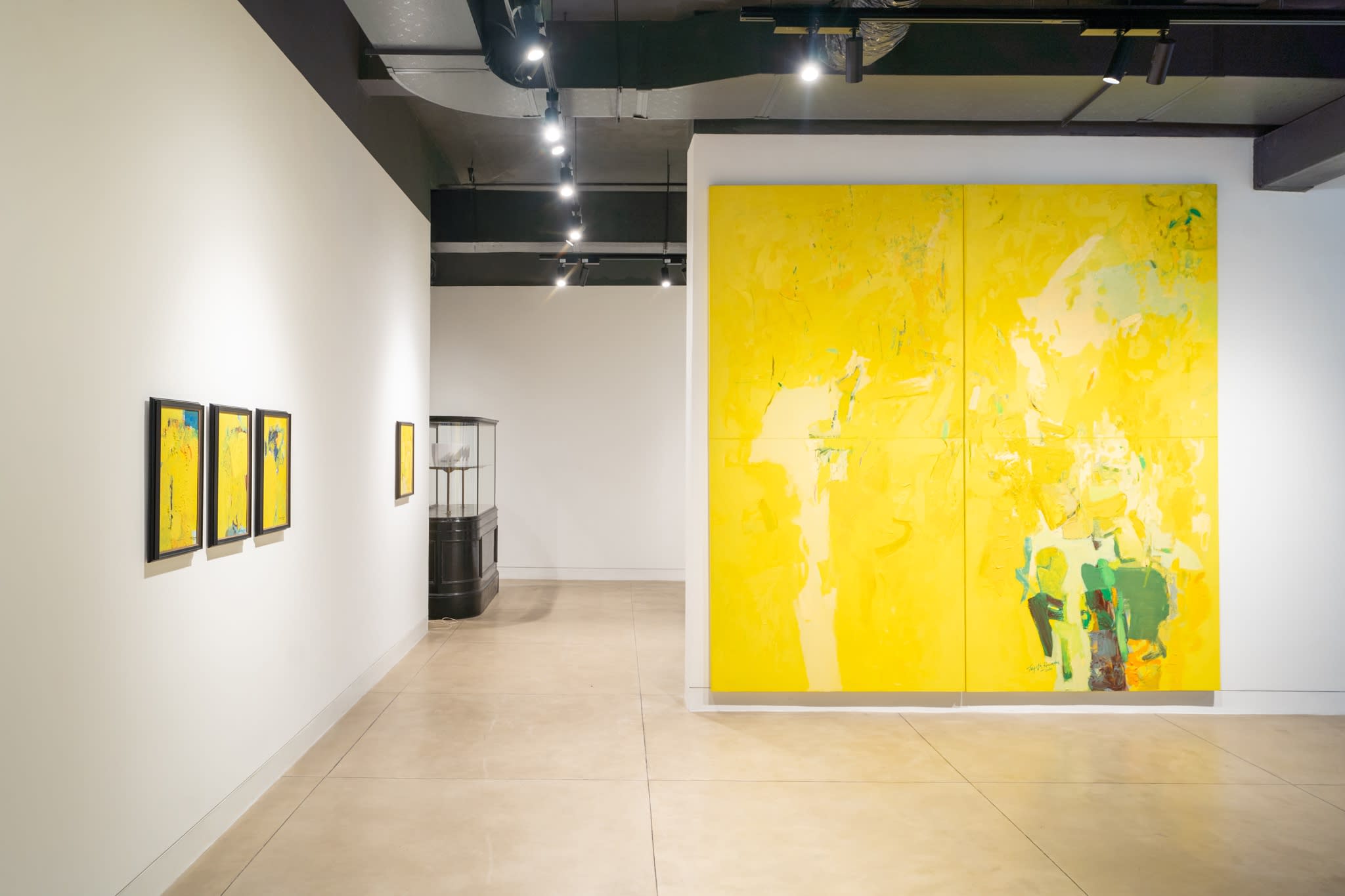 |
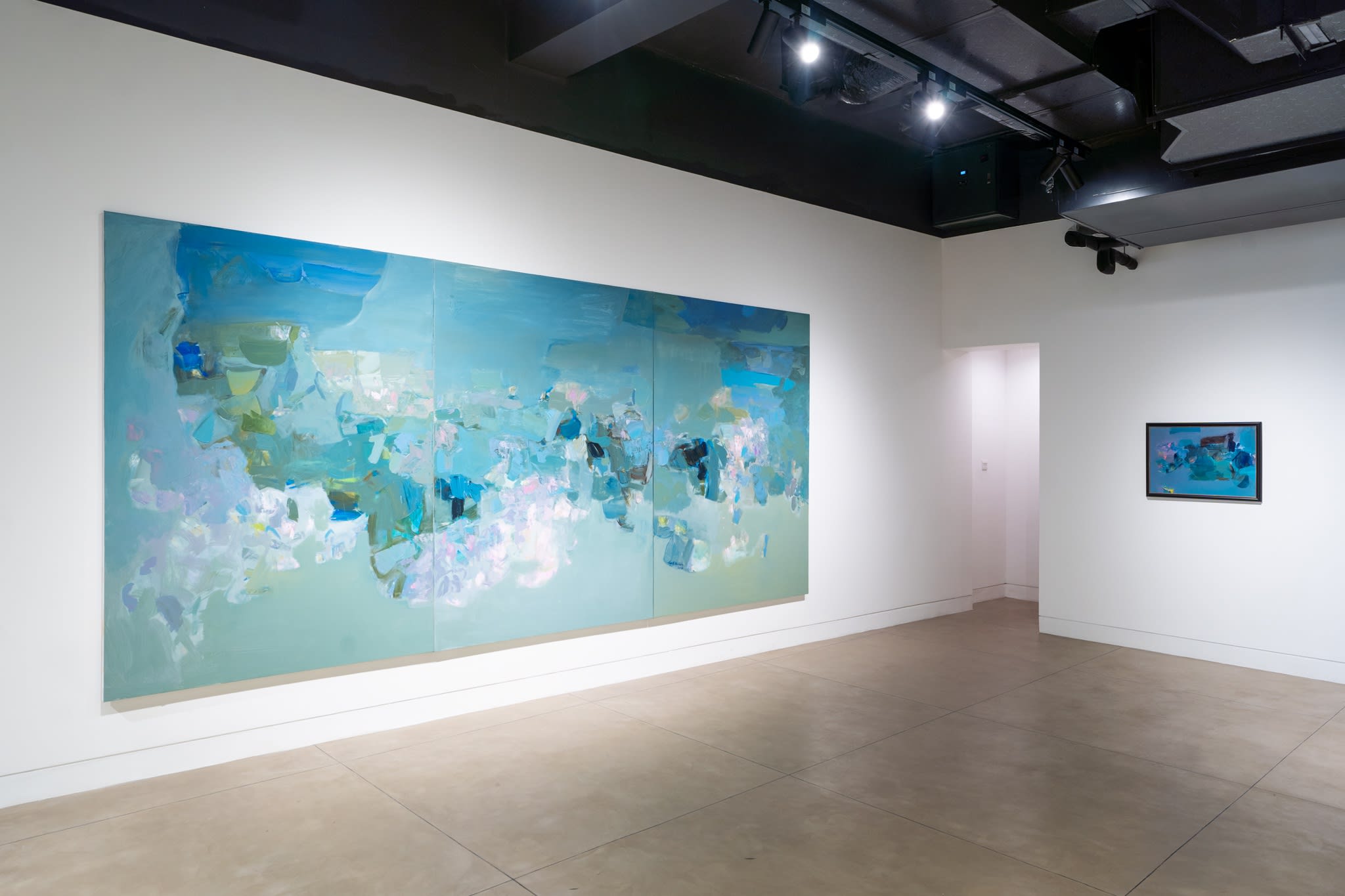 |
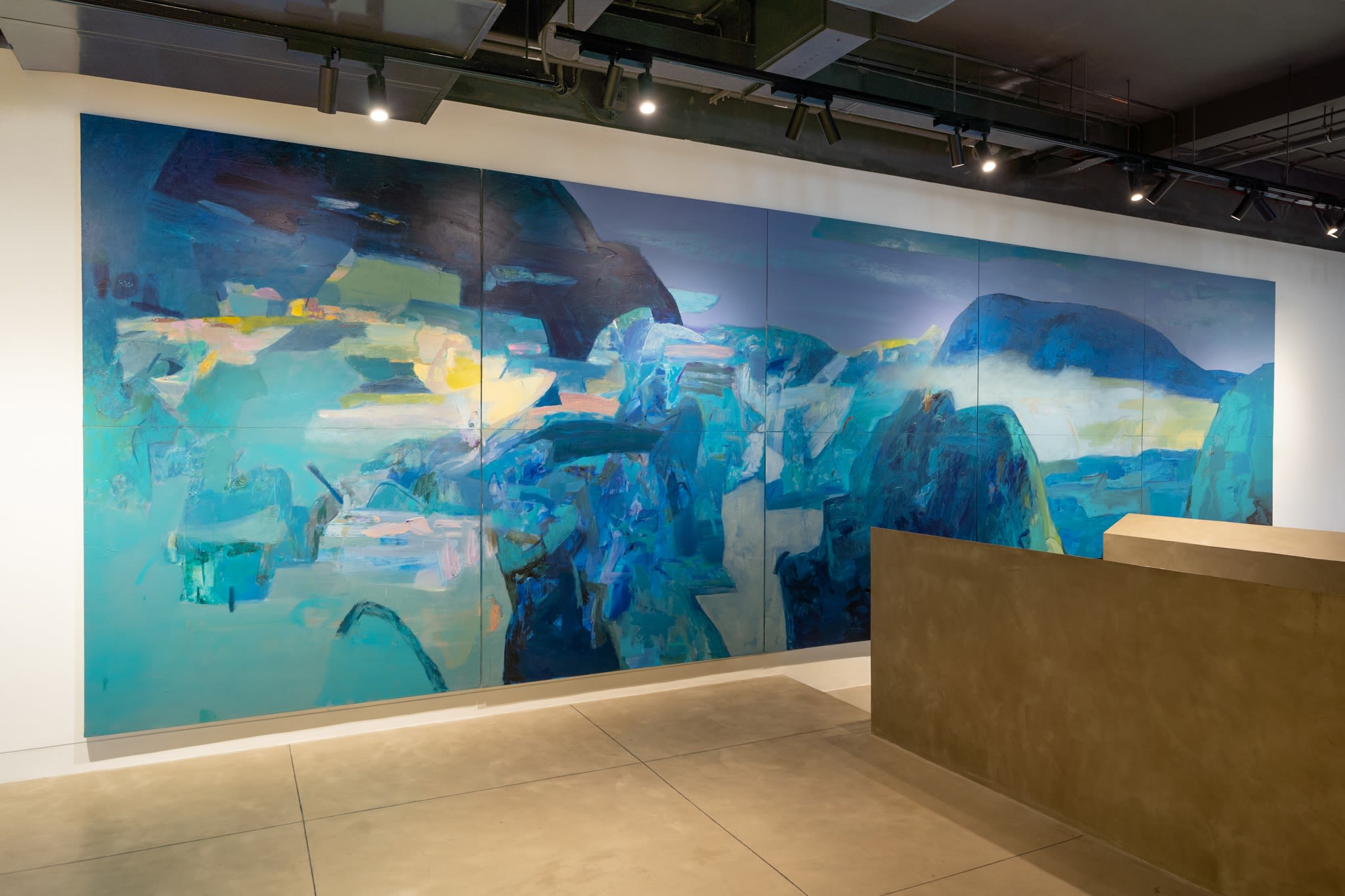 |
I am interested in capturing the emotions that arise through my engagement with the environment around me and the ideas I attempt to unpack. I enjoy working with the grammar of abstraction. The way we think, as I understand it, is shaped by our neurochemistry, education, experiences, and everything we learn, read, and absorb. All of this informs our visual language as artists. As individuals, we tend to hold on to what resonates most deeply with us. I am deeply drawn to the harmony that emerges between deliberate, premeditated actions which emerge from both conscious and unconscious processes — and those that arise spontaneously, without planning. This is perhaps why I prefer working with the grammar of abstract art.
For me, abstraction is not about form alone. It is an expression of one’s inner makeup— an articulation of thought, emotion, and personal philosophy.

Jagath Ravindra in his studio
What are your thoughts as an academic on contemporary abstract art?
Abstract art, like many other movements, began as a response to a particular historical moment. What we practice today, as contemporary artists, is more a subset of the grammar and style that emerged from that context. The movement once carried a set of values and principles shaped by its time, but that moment no longer exists.
I don’t believe there are truly abstract artists anymore. The environment that gave rise to the movement has shifted. Today, abstract art feels less like a movement and more like a trend or fashion. Much of what is now labeled as abstract art simply reflects the stylistic features that once defined it. I often find myself reluctant to categorize many contemporary works as abstract.
As I see it, abstract art today tends to imitate the superficial elements of its visual language. For me, abstraction is not about form alone. It is an expression of one’s inner makeup—an articulation of thought, emotion, and personal philosophy.
Take, for example, H.A. Karunaratne. It took him nearly fifty years to create a body of work that truly reflected his inner world. I take joy in the process of applying colours and create large scale works. For me, abstraction is about finding freedom and discovering something extraordinary within it. It took me over a decade to arrive at that kind of liberated expression.
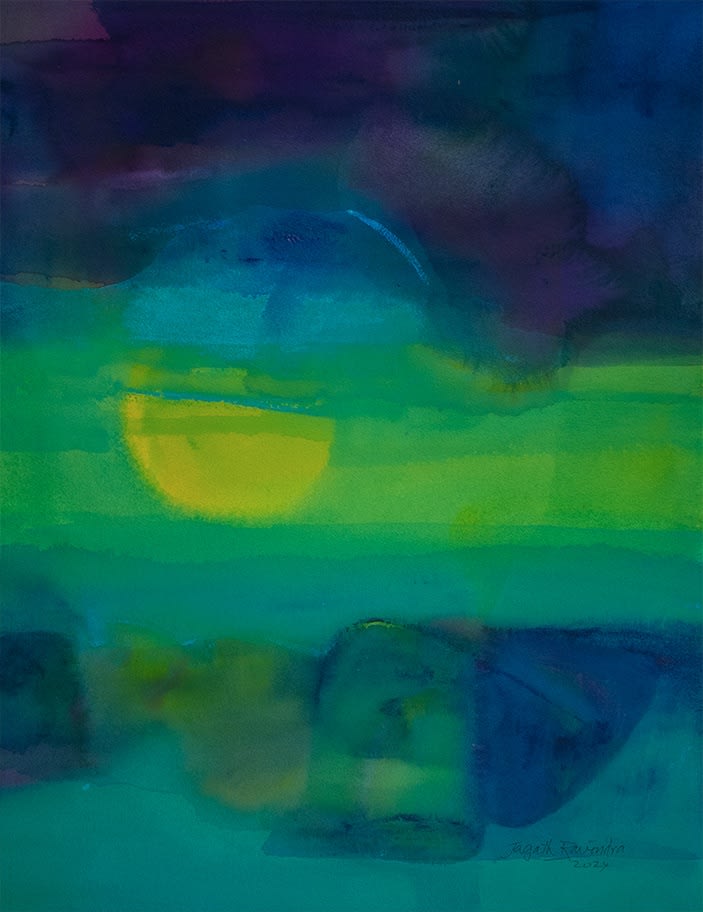
Mountains in Moonlight 3, 2024, Water Colour and Acrylic on Paper, 68.8 cm X 53 cm

Mountains in Moonlight 2, 2024, Water Colour and Acrylic on Paper, 68.8 cm X 53 cm
Which artists or movements have had a significant influence on your work?
I have always been enamoured by Justin Daraniyagala work. His painterly language is charged. He is an artist who exhibits remarkable skill in painting the human form using a dry brush, without much linseed oil or turpentine. I also think George Keyt was exceptional for having found inspiration in Indian culture and myths and interpreting these traditional forms with lines and colours that was quintessentially modern in style. Among others I recount Tilak Abeysinghe, Stanley Abeysinghe, Sumana Dissanayake, Rubert Soysa and H.A. Karunaratne. My contemporaries such as Kingsley Gunatillake have also been an inspiration.
Can you take us through your process?
My process is deliberate. I tend to not rush my work. My process is quite simple. Mine is a desire to work with colours and create expansive works. Once I put an idea to paper, the idea is lost to me. Hence I don’t sketch beforehand. My process involves thinking through an abstract idea and creating the image in my mind. It builds up over a prolonged period of time, and I am able to release it onto my canvas as an explosion. Often music aids in the process and I can paint at a stretch for days.
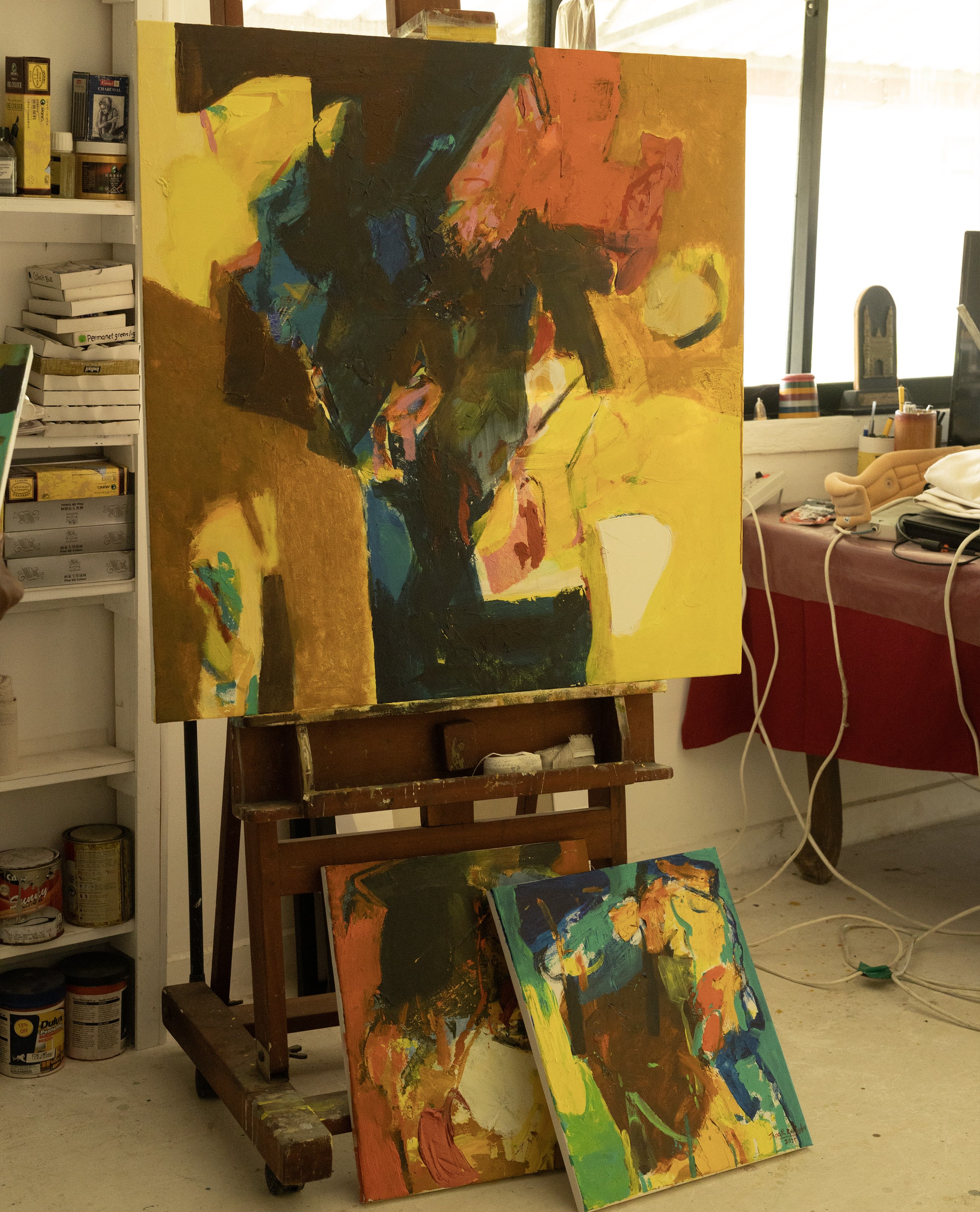
Jagath Ravindra's Studio
Your use of colour is a fundamental aspect of your practice. Can you elaborate on how you understand and use colour in your work?
Indeed my strength as an artist lies in how I use colour in my work. From an extensive use of red, brown and black colours, I have shifted to a palette that is much softer in tone. In fact, I used to dislike the colour green. However, it has now become one of my favourite colours. In the Ehela series, I began by exploring the full depth of yellow—now, it is gradually evolving, merging into shades of blue and green.
There is a sense of liberation I experience in using these colours freely. I let myself wander and the canvas becomes a testament to the freedom I experience.
Are there recurring themes that appear in your work?

I have been creating artworks for close to forty years now. From works that used to be highly charged in content during the early years of the civil war, I began creating works that inclined strongly towards beauty and harmony by 2009. My colour palette has changed from deep reds to gloomy and then lighter colours. Between 2009 and 2016 I did not create any work, and I strongly feel I found myself then. In 2016, I created the series Blooming Beauty, with which I transitioned to a language that celebrated the wondrous. Today, I am more inclined towards themes of beauty and harmony. I am also exploring romanticism - I feel it is a language and a movement that has not received due value within the scope of art history.
What kind of a role does music play in your practice?
Music plays a pivotal role in my work. It becomes a way to inspire colours in my mind. We often retain the images that we see in our surroundings, such as the cracks on the earth or the characteristics of the human form, which are retained as files in our memory. Music, to my understanding, enables us to open these files, and in my case they spill on the canvas as colours that resonate with the ideas that I have been engaging with. I mostly listen to music by Ravi Shankar, Anoushka Shankar and Hariprasad Chaurasia.
What is an unrealised project?
I've always been drawn to creating large-scale works. While I have the energy to do it, I want to realise an artwork on a scale I’ve never attempted before. It’s an idea that’s been quietly taking shape in my mind for over a decade. I want it to captivate the viewer and overwhelm them with the impact of its scale.

Jagath Ravindra
